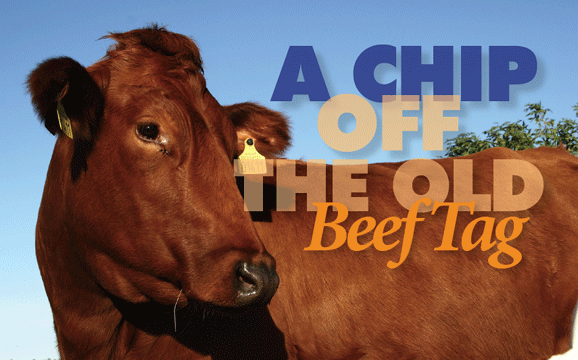FREQUENCY IDENTIFICATION (RFID) has been around for some time. It is wireless technology that uses three components: a tag (which consists of a microchip and a radio antenna), a reader, and a computer system. Most of us are familiar with its uses in Florida’s SunPass prepaid toll system or the microchips implanted in our pets for identification. [emember_protected custom_msg=”Click here and register now to read the rest of the article!”]
RFID is also used in ear tags to identify Florida’s cattle. Florida is currently 10th in the nation in terms of calf production, according to Todd Thrift, assistant professor of beef cattle management at the University of Florida. The technology is used most extensively in the industry between the feed lot and packing segment to track individual animals, but on the ranch level, RFID use has been limited.
The low-frequency electronic identification tags (EIDs) are read by handheld scanners or fixed readers attached to alleyways, chutes, or feeding areas. The data is downloaded into a computer and organized into spreadsheets. Instead of the time-consuming method of written spreadsheets, producers can easily and accurately track information on individual cows such as weaning weight, pregnancy status, and treatment records.
Some producers use RFID to track ownership of cows. The Seminole Indians, for example, have used it when they have multiple owners of cattle on one ranch. It’s also used by larger cattle operations because it is a more efficient way to manage the numbers than the normal ear tags. Pure-bred operations use it to track the history of higher-value animals.
Thrift says the big advantage he sees is when transferring cattle. He sends his calves from Florida to Kansas, where they are grazed for six months before ending up in a feed yard in Texas. He can track their performance in Kansas and ultimately through the packing process, provided the data is scanned and cataloged.
Although the technology can be used as effectively on smaller operations, most don’t find it to be an advantage. For some ranchers, the difficulties of limited EID reading distance (usually just a few feet) and EIDs placed in normal ear tags that may fall out, are not worth the investment.
The system cost is not really prohibitive. The ear tags run about $2 each. The reader(s), computer, and software run about another $1,000. But Thrift says, “Most guys just don’t see a benefit to doing it. They can manage their cows without all the technology.” He adds that many cattlemen have not adopted it because it’s more of a part-time business for them: “It’s not a livelihood, it’s a lifestyle choice.” For them, the economic incentives may be secondary.
That’s not the case for David Beerman, however. As the foreman at Stokes Groves, Inc., he’s been very happy with RFID technology in their cow-calf operation. They originally purchased a system about five years ago to check the weights on cows while in the chute. They started using EIDs about the same time, and are now able to check each cow’s history when they scan her EID tag. It’s a good management tool to track daily how she’s been bred, if she has ever missed, and so on. Cows that miss twice are beefed. Beerman says, “Having a good, young cow herd is the way to go.” The RFID system aids in their productivity. “You don’t want … cows that are hit and miss and don’t have calves every year.”
Beerman says they still have someone writing on paper spreadsheets as a backup when palpating in the summer. And if they occasionally lose an EID, they have two other means of ID — a regular ear tag and the vaccination tag.
“There’s no right or wrong way,” Beerman adds. “Every place just has to do what works for them.” At the Stokes operation, they track what heifers weigh in June when they receive the ear tags, in August when they are weaned, and what they were gaining between different intervals until they are bred in December.
M.J. Carnevale, an environmental scientist for the City of Winter Haven Natural Resources Division, agrees that RFID is a powerful herd-management tool. His experience comes from having managed a pure-bred genetics program at a ranch in South Florida. They had high-value cows they kept around longer than a normal cow-calf operation and they leased out bulls and cows to people interested in their genetics. To aid in tracking the location of each animal, they used EIDs with GPS built into them. Although not every calf would need that much traceability, the good breeders and bulls should have it.
Carnevale believes the best use of RFID technology is as an internal mechanism. Especially in breeding programs for higher-value cattle, “there’s a huge benefit in being able to see what’s working and what’s not working.”
Until recently, the software that interacted with RFID tags was still fairly complicated. But changes in technology, including tablets and smartphones, have made it more user friendly, and that “creates more accessibility to more people. It’s easier to realize the benefit,” observes Carnevale, who believes that this is a step in the right direction for making electronic management of data on the ranch more prevalent.
CREDIT
story by JANA HUSS [/emember_protected]

